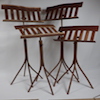I have acquired two ancient beautiful 2x6 pieces of grey weathered barn-wood that look like they are 100 years old. I want to make a picture frame of them.
My problem is that I only have two pieces and will need to rip them. When I rip them, I assume the color of the ripped surface will not be grey but more normal wood color.
Is there a way to artificially age these surfaces and make them look like old grey wood?
Thanks




 Reply With Quote
Reply With Quote






